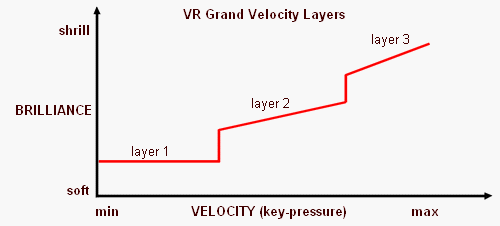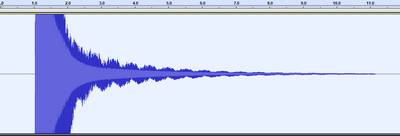VR Acoustic Pianos
This is a detailed analysis of the VR acoustic piano (Grand) sound that can help you understand why it is as ‘bad’ as it is and why there is no miracle to ‘make it better’
The VR ‘APs’ (Acoustic Pianos) lack in a lot of things (to understand the terms, reading the Stage Pianos essay about digital pianos will help)
In short: Heavy issues are: the quality of VR ‘note’ samples spreading widely from ‘ok’ to ‘tin can noise’, high volume samples being too harsh, tone decay too short and bad sounding (artificial), the action of VR09 badly calibrated for piano.
Subtle issues are: the absence of all whisles and bells of ‘Grands’ that are standard in even low level DPs (and in the VR predecessors…): enhanced ‘modelling’, sympathetic string resonance, chassis resonance, mechanical damper noise, etc.
In detail:
- velocity samples: on a real piano, if a key is hit harder, the tone not only sounds louder but also changes its timbre. To reproduce that change DPs use different samples for certain dynamic ranges (the best digitals use 7-8 or more different samples per note). These samples are called velocity samples or velocity layers. Modern DPs add ‘algorithms’ to smooth the transition from one sample to the next (so called modeling of the sound): in a good DP, when repeating one note by constantly increasing key pressure, you barely can hear the switch to the next velocity sample. Roland calls this technology ‘SuperNatural’.
VR Grands use 3 velocity layers with only very limited ‘transition modeling’: the lowest velocity sample is not modeled at all, some ‘velocity dependend brilliance’ is added to samples 2 and 3. Playing near the transition-‘switch’ between 2 velocity samples results in random flipping between the samples and especially the switch from 2nd sample to the very shrill sounding 3rd sample is very unpleasant and disturbing
- sample quality: The quality of the (velocity) samples of the VR Grands has big variations: depending on the note range (or single tones) and the ‘velocity layer’ there are good souding samples and others that sound like hitting a kitchen pan. Unfortunately the C4-C5 ‘main octave’ has some of the most kaputt samples (D-F#)
- knocking on heavens door…: one of the few gizmos added to the VR APs is the mechanical ‘knock’-noise when hitting a key and actuating the hammer.
In the 2nd and 3rd velocity layer Roland engineers exaggerated that noise: playing through a powerfull speaker results in a wild tock-tock-tock-tock that cuts through the piano sound itself - minimum velocity: On a ‘real’ piano (or entry level digital) when a key is pressed very slow, there is no sound (it’s too slow to engage the hammer)
VR produces a sound even if the key is pressed the slowest thinkable way – and the ‘lowest volume’ is far too high. This extremly disturbs dynamic expressiveness especially for ballads or ‘classic’ oriented piano play
- decay time: decay is how a note fades out if you hit and hold a key or use the sustain pedal
Decay time of the VR Grand is way too short, resulting in low richness of the sound. Compared to Casio PX stage piano:
lowest C (C1): PX: 30 seconds – VR: 13 seconds
middle C (C4): PX: 20 seconds – VR: 10 seconds - decay looping: on top-spec digital pianos, the entire decayed sound comes from one long sample. Long samples need a lot of (expensive) memory, therefore entry level stage pianos use short samples that are ‘looped’ (repeated) to construct a long decay tone. You can hear the restart of each loop as a periodic ‘hiss’. Roland SuperNatural technique uses modelling to balance the restart of each loop: even on the basic FP10 you cannot hear any looping.
VR uses very short samples and NO SuperNatural decay modelling: especially in the high octaves the looping is very pronounced at a high rate and results to very artificial and sterile sounding decays full of high noise artefacts VR Gand decay looping of note C4
VR Gand decay looping of note C4 - sustain: on a real piano, the timbre of a note differs between damped and undamped (sustained) mode. DPs use different samples for damped and undamped, or change the timbre by modelling (Yamaha, Roland SuperNatural)
VR uses the same samples for damped/undamped: ‘sustained’ notes are simply ‘elongated samples’ (without any SuperNatural modeling) - sympathetic string resonance: on a real piano, playing a note ‘excites’ the strings of other keys, the so called ‘string resonance’. This effect becomes really strong when the piano damper is off (sustain pedal pressed) and the entity of all strings is ‘excited’ and does freely vibrate. Resonance contributes very much to the richness and opulence of a piano. DPs add resonance using samples and/or sound algorithms (Roland SuperNatural modelling). On most DPs string resonance can be customised
VR does not add any sympathetic string resonance, resulting in less ‘richness’ of sound. The absence of string resonance is negligible in a rock band but comes into play when soloing the piano - damper noise, chassis hall etc: on a real piano you have all kinds of ‘noise effects’, e.g. a ‘hall’ of the chassis, a ‘klonk’ sound when actuating the damper pedal etc… DPs more or less add these ‘authentic’ sounds (the more expensive the more noises).
VR does not add any of those ‘noises’ – with on exeption : the mechanical ‘ploc’ sound when pushing down a key – which is totally overemphazised on the VR and competes the drum set of your band ….
For statistics: some features listed abouve were implemented in the VR predecessors (VR760, VR700) and have been dropped in VR09/730